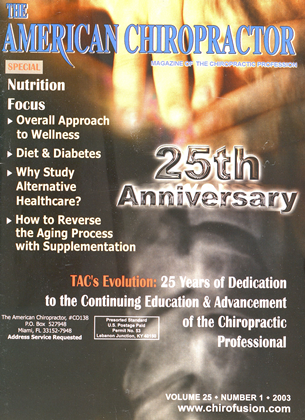reverse myopathology Myopathology is considered by most, if not all, chiropractors to be a component of subluxation. This is a reasonable view, as degenerative changes are known to occur in muscle after injury, during hypomobile states, and as part of the so-called normal aging process. Most will recall that muscles, and all other cells for that matter, function properly as a consequence of mitochondrial production of ATP (adenosine triphos-phate). In Dr. Janet TravelPs famous text on trigger points, she explains that TP's are characterized as areas of "energy crisis" within muscle. It is now known that mitochondrial dysfunction is responsible for promoting cell injury and death. For details on this relationship, see Robbins' pathology' and specialty texts devoted to this subject.2 Aging, neurodegenerative diseases, heart disease,2 and most other chronic diseases are promoted by, or at least associated with, mitochondrial dysfunction. Coenzyme Q10 appears to be the most important mitochondrial factor that we can use in supplemental form. CoQIO produces several well-documented effects, including energy production and antioxidant defense, and it is now thought that CoQ 10 regulates global gene expression in skeletal muscle. Consider these important functions in light of the fact that body tissue loss of CoQ 10 as we age is massive.3 (See Table 1). These dramatic losses should also be considered in the wake of "statin" drug prescriptions for cholesterol reduction. CoQ 10 reductions with age can be compounded by statin drugs. For example Lovastatin can reduce serum CoQ 10 levels by as much as thirty percent.3 During the aging process, a "damage mosaic" develops that is unique to each individual. During the lifetime of an individual, mitochondrial DNA undergoes a variety of mutation events and rearrange- ments. These mutations and their consequent bioenergetic decline, together with nuclear DNA damage, contribute to the reduced function of cells and organs4. In skeletal muscle, this functional decline can be observed by means of changes with age in fiber type profile, and by the reduction in number and size of the muscle fibers. In a recent trial, human subjects about to undergo hip replacement surgery received 300 mg CoQ 10 per day for 25-30 days before surgery, whereas control subjects received placebo treatment.4 At the time of surgery, samples of vastus lateralis muscle were taken from the same regions in both dllU JJCI1C illlU piOlClll CA.JJIC6SIU11 patterns and muscle fiber type profiles were compared between placebo and CoQ 10-treated subjects. Those taking CoQ 10 demonstrated a dramatic change in muscle fiber types towards profiles of young people,4 in other words, myo-pathology of aging was reversed. Nutritional replenishment of coenzyme Q10 requires a higher level than is available in most food (highest in pork hearts and chicken legs; low in fruits and veggies). The normal level in blood is around 1 mg/mL. To increase the concentration significantly requires at least 100 mg/day which increases the level in blood to around 2 mg/mL.1 An increase to 2 mg/mL in blood can be therapeutic for various conditions; this may indicate that a high blood level is needed to get coenzyme into deficient tissues. Even with large amounts of heart or herring in the diet, it would be difficult to supply 100 mg/day.3 In a more recent study publicized in the media, CoQ 10 supplementation was re- ported to delay Parkinson's disease (PD) progression. Patients were followed for up to 16 months, and it was determined that coenzyme Q10 was safe and well tolerated at dosages of up to 1200 mg/day. Less disability developed in subjects assigned to coenzyme Q10 than in those assigned to placebo, and the benefit was greatest in subjects receiving the highest dosage. Coenzyme Q10 appears to slow the progressive deterioration of function in PD, but these results need to be confirmed in a larger study.5 See page 50 for References Dr. Seaman is the Clinical Chiropractic Consultant for Anabolic Laboratories, one of the first supplement manufacturers to service the chiropractic profession. He is on the postgraduate faculties of several chiropractic colleges, providing nutrition seminars that focus on the needs of the chiropractic patient. Dr. Seaman can be reached by e-mail at doc(a)lesspainbettergolf.com. Coenzyme QlO may
 View Full Issue
View Full Issue






